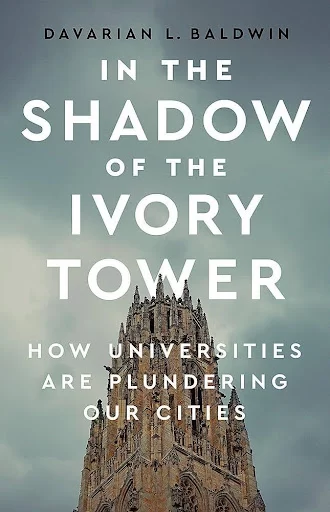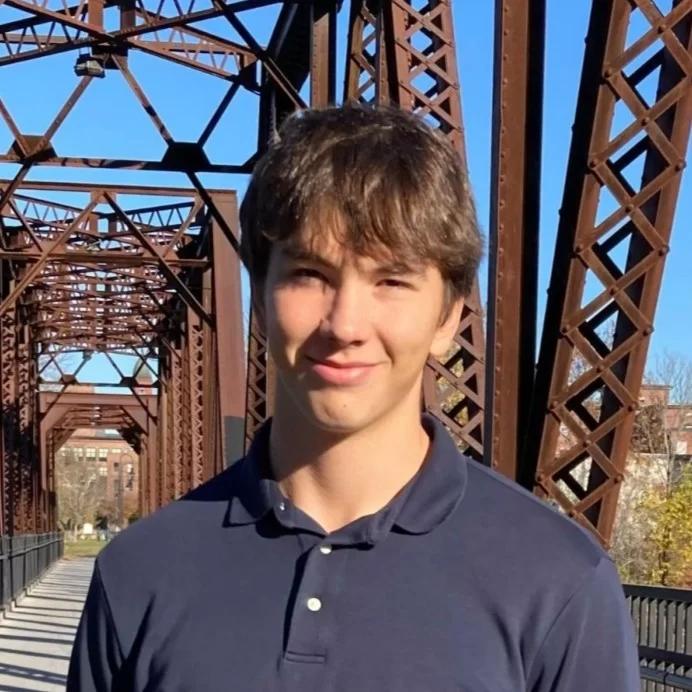Student Reflections on the work of Dr. Davarian Baldwin
This past Fall, the Harward Center hosted a faculty/staff book circle focused on Dr. Davarian Baldwin’s book, In the Shadow of the Ivory Tower: How Universities are Plundering Our Cities (2021). Facilitated by Associate Professor of Digital and Computational Studies Anelise Hanson Shrout, the book circle brought twenty faculty and staff together for three lunchtime discussions of the provocative ideas presented in the book. Inspired by these discussions, the Harward Center teamed up with the college’s Office of Equity and Inclusion to host the author at Bates at the end of February. During his visit, Dr. Baldwin gave a public presentation, met with book circle members and other interested faculty and staff, and also made time to meet with students. In this blog post I share reflections on some of the issues raised by Baldwin from a student standpoint.
In his book and public presentation at Bates, Baldwin discussed how across America, universities have become big businesses—and the cities they are located in are becoming new versions of “company towns.” Universities bring plenty of assets to the communities where they are located, but there is a clear cost to those who live in their shadow. Among the negative impacts of the expanding economic power of colleges and universities is gentrification, as the neighborhoods nearest campus are often bought up for housing and other services aimed at the campus community, resulting in the displacement of current residents. Many universities also have their own policing units and policies, which often lead to profiling and other exclusionary practices for off-campus community members. While most colleges and universities have programs aimed at supporting positive campus-community relationships, Dr. Baldwin noted that many of them prioritize campus-based outcomes, such as student learning or convenient retail options, over community well-being; as such, these programs arguably do more harm than good when it comes to the wider community. We might wonder if these programs and centers have the community’s actual interest at heart, or if they are merely the next “shiny thing” to feature in an Admissions brochure or to pad students’ resumes.
With these arguments in mind, I spoke with one of the Bates students who was able to attend Dr. Baldwin’s presentation and also meet with him the following day to continue the conversation. Isaac Levinger ‘24, a Harward Center Bonner Fellow, sociology major, and a member of the Varsity Men’s Crew team, was one of several students who had the chance to sit down with Dr. Baldwin during his time at Bates.
Among the cautionary tales relevant to Baldwin’s argument that Isaac and I discussed was Yale University in New Haven, an institution notorious for displacing residents as it buys up much of the city. That’s an example of a “hostile takeover.” Also in Connecticut, at Dr. Baldwin’s own institution, he mentioned how Trinity College chose to locate its community engagement center in a richer area of Hartford instead of an area that would benefit substantially more from community engagement work. For me, I immediately think of Columbia University in NYC and its displacement of low income Harlem residents in order to expand the university’s footprint.
With these examples in mind, I asked Isaac what he thought about Bates’s Harward Center for Community Partnerships. Does it do more harm than good when it comes to Lewiston? While Isaac and I agree that Bates can still do a lot better when it comes to college-community relationships, we also believe the Harward Center is operating considerably better than the aforementioned schools. Isaac specifically mentioned Aspirations Days, which bring middle school students to Bates to learn about diverse possible future pathways, including college and vocational training, and explore their questions about higher education. Considering this and other programs, Isaac noted that “the work supported by the Harward Center is done mindfully, so that the emphasis is less about Bates and more about Lewiston.”
A key to this approach is the fact that most Harward Center staff live in and are deeply involved in the local community, not simply through their Bates jobs but in every aspect of their lives. As a result, they have knowledge about community issues because they are part of the initiatives that are addressing those issues, and they have long-term relationships with a wide range of people and organizations that inform the work they do at Bates. Isaac singled out the amazing work done by Peggy Rotundo and Kristen Cloutier. Peggy, a Maine state senator, used to work at the Harward Center and was a highly effective connector of students to local and statewide opportunities. Kristen, who was the previous Mayor of Lewiston and is now Assistant House Majority Leader in Augusta, is also the Harward Center’s Associate Director for Center Operations, exemplifying for Bates students what a life of public service can look like. “Peggy and Kristen’s primary interests are Lewiston and Maine, so they are finding students with much more aligned values rather than just getting jobs for kids.”
Of course, Bates is still an elite college that has a lot of wealth compared to the rest of Lewiston, which naturally causes friction. The reality is that the Bates annual tuition ($83k) is double the median annual income of Lewiston residents. “The Bates Bubble” is real, and something both Isaac and I experience first hand. Unless we engage with Lewiston directly, with guidance and support from the Harward Center, it is very easy to see Bates and Lewiston as totally separate. In all, Dr. Baldwin’s talk and work reminds us to be mindful of the cities/towns we consider temporary homes, as it is much more permanent for the people already living here. “We must make sure local people don’t get priced out of their community spaces, and ensure we are mindfully engaging with them for the right reasons and in the right ways.”


